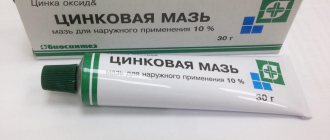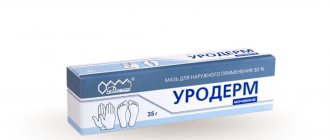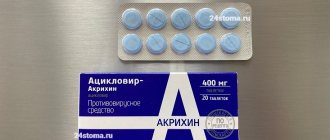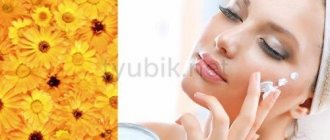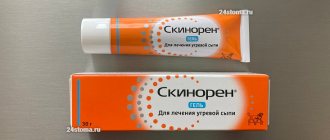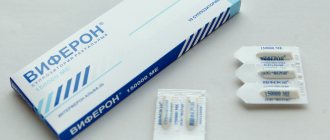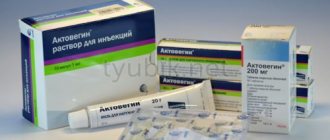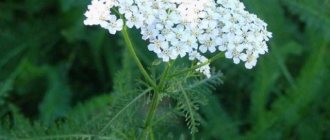Balsamic liniment (also known as Vishnevsky's ointment or liniment) is widely used in medical practice for various diseases.
The high effectiveness and safety of the drug made it especially popular. It is often used without medical prescriptions, self-prescribed for suppuration and various purulent ulcers and wounds that need to be cleansed of necrotic contents, making it impossible for them to heal.
The drug was created by Russian surgeon A.V. Vishnevsky in 1927. An effective medicine does not lose its popularity today, despite the abundance of antibiotics. Having a minimum of contraindications, the ointment can be used for most injuries and many diseases in children and adults. The product is now found in most home medicine cabinets in Russia and the CIS countries.
Composition and medicinal properties of the ointment
Balsamic liniment has birch tar as its main active ingredient.
Vishnevsky's ointment contains only 3 components, each of which enhances the effect of each other.
- Purified birch tar. This component is natural. It is obtained from birch bark. Tar looks like a thick, dark, viscous liquid. This is the strongest natural antiseptic that is effective against most pathogenic bacteria that can cause inflammation in humans. Additionally, the component actively enhances blood circulation at the site of application and increases the ability of tissues to regenerate. The property of tar to eliminate pain, burning and itching is also valuable. Its use is also possible on wet wounds, since the substance helps dry them. For burns, wounds, bruises and wen, tar has been used for a long time.
- Castor oil (a number of manufacturers replace it with fish oil, but this is not a desirable option). The component in the ointment enhances its ability to quickly penetrate tissue. Additionally, the substance in combination with tar also acts as a strong sedative for the affected skin, relieving pain and itching.
- Xeroform. Promotes drying of the wound surface and enhances the antiseptic effect of the drug.
The ratio of active ingredients in the drug is as follows:
- 94% castor oil,
- 3% tar,
- 3% xeroform.
The smell of the ointment is specific and very pungent, which is provided mainly by tar. Even under a bandage, it is clearly noticeable to others. The color of the drug, depending on the manufacturer, is brown or dark dirty yellow.
The drug is produced in the form of liniment, which is thinner than ointment and penetrates tissue more easily.
The main medicinal properties of Vishnevsky’s ointment (liniment) are as follows:
- local immunomodulatory;
- pulling (cleansing);
- antiseptic;
- bactericidal;
- healing;
- pain reliever;
- antipruritic.
In some cases, it is recommended to mix the medicine with Shostakovsky balm (vinilin). The drugs enhance each other’s actions and have an even more active effect on the body.
The ability of the drug to stimulate the regeneration of the skin and deeper tissues allows it to be used to treat third-degree burns, which in this case, after healing, do not leave strong scars, which is of great importance for tissue damage in open areas of the body.
In addition to skin lesions and injuries, the ointment is also used for internal inflammation of the genitourinary system and mammary glands.
The drug is prescribed in the following areas of medicine:
- gynecology;
- dermatology;
- traumatology;
- surgery;
- urology;
- proctology;
- dermatology;
- cosmetology.
The product is available over-the-counter because it is not an antibiotic or hormonal drug.
Vishnevsky ointment: composition and release form
Vishnevsky ointment, instructions for use confirm this, is created on the basis of birch tar, xeroform and castor oil. Liniment can be of different shades: from light yellow to green-brown. A characteristic feature of the product is its characteristic smell.
The active substances have a powerful healing effect due to their properties, such as:
- Birch tar with a pronounced, recognizable odor is a strong natural antiseptic with a wide spectrum of action. It is able to destroy harmful microorganisms and activate blood circulation, which accelerates the processes of healing and tissue restoration.
- Xeroform is a synthetic aniseptic that has a targeted destructive effect on the structure of bacteria. It enhances the effects of birch tar and accelerates tissue regeneration.
- Castor oil has weak wound healing properties and also has a drying and softening effect. Thanks to it, the penetration of other components deep into the tissues is enhanced, and negative reactions of the body, such as pain and itching, are relieved.
An additional component in the ointment is colloidal silicon dioxide, which is classified as an enterosorbent. The substance accelerates tissue regeneration processes.
You can purchase Vishnevsky ointment in dark glass jars or aluminum tubes. The dosage of the drug can be different: from 15 to 30 mg.
How to use Vishnevsky ointment correctly?
Vishnevsky ointment is actively used to treat purulent abscesses, due to which they resolve and heal faster. Thus, the inflammatory process, which could last for a week or 10 days, is reduced on average to a day.
The boil ripens, the skin covering it bursts and purulent contents come out. Thanks to the ointment, no further suppuration occurs, and the wound heals without scar formation.
When should you use Vishnevsky ointment:
- Acne;
- Inflammation of the gynecological area;
- Gangrene, thrombophlebitis, varicose veins, trophic ulcers, endarteritis;
- Frostbite, burns;
- Bedsores;
- Psoriasis;
- Dropsy, swelling.
Application of ointment
Balsamic liniment has numerous indications for use. Vishnevsky ointment must be used correctly for various diseases in order to get the highest possible results.
The main indications for the use of balsamic liniment ointment according to Vishnevsky are as follows:
- abscesses of various nature;
- trophic ulcers of diabetic nature;
- ulcers due to varicose veins;
- bedsores;
- thermal burns;
- severe chemical burns;
- frostbite;
- inflammatory lesions of the lymph nodes;
- carbuncles;
- boils;
- boil;
- extensive abrasions;
- infected purulent wounds;
- psoriasis;
- thrombophlebitis of varying degrees;
- obliterating arterial endarteritis;
- acne;
- weeping wounds on the skin;
- haemorrhoids;
- soft tissue phlegmon;
- empylem complicated by sepsis;
- osteomyelitis – purulent inflammation of the bones;
- postpartum ulcers.
These are only the main indications for treatment with Vishnevsky ointment. In addition to these, doctors recommend the drug for many other disorders.
Vishnevsky ointment: indications
Vishnevsky ointment, the composition of which is very simple, is indicated for the treatment of various injuries to the skin and soft tissues. Liniment is most often prescribed for treatment:
- Acne and abscesses of various etiologies.
- Boils.
- Ulcers caused by diabetes or caused by varicose veins.
- Infected purulent wounds.
- Burns and extensive abrasions.
- Bedsores.
- Gynecological pathologies.
- Hemorrhoids.
Instructions for use of Vishnevsky ointment (Method and dosage)
The use of Vishnevsky ointment is carried out externally - in the form of bandages, tampons, compresses. The instructions for Vishnevsky's ointment are as follows: balsamic liniment is applied two to three times a day to the affected area in a thin layer.
Application for boils and other skin lesions also involves making and applying a gauze bandage from 5-6 layers of gauze, which is pre-impregnated with the product. The bandage is fixed. It is also possible to apply the drug to the wound using a napkin soaked in the product. It must be applied so that the ointment completely loosely fills the wound. Dressings should be carried out until the wound is clean. Vishnevsky's ointment for acne is used by applying bandages or a patch with ointment to the place where the rash appears. If you need to use a remedy for subcutaneous acne, you need to apply a thin layer of it to the place where the pimple forms under the skin. There is a pronounced positive effect when using an acne remedy. Reviews indicate that with proper use of the product, acne also decreases. The drug for boils is used in a similar way.
Treatment of boils with Vishnevsky ointment should be carried out until they disappear completely. Vishnevsky ointment in gynecology is used to treat inflammatory processes of the pelvic organs. The use of Vishnevsky ointment in gynecology is carried out by using tampons soaked in the product. Tampons with ointment are inserted into the vagina. But such a procedure can only be carried out on the recommendation of a doctor and you must strictly follow his instructions. It is the specialist who gives clear instructions on how to make tampons with Vishnevsky ointment. In gynecology, tampons are used, each of which is impregnated with no more than 15 g of product. The course of treatment lasts at least a week. Vishnevsky ointment for hemorrhoids is applied externally. Hemorrhoid ointment is applied to a strip of gauze folded in several layers and applied to the place where the hemorrhoids are localized.
This compress should be changed once every 12 hours. When the inflammatory process gradually decreases, treatment of hemorrhoids with ointment continues for several more days, but compresses need to be done at night. Reviews for hemorrhoids about this treatment are usually positive. However, before starting to use Vishnevsky ointment, you should definitely consult with a specialist and act according to his recommendations. If there are no positive results of treatment or if the situation worsens, you should immediately consult a doctor.
For hemorrhoids
The drug is used for the treatment of hemorrhoids as an adjunct to complement the main therapy. The ointment is used in postoperative therapy (after removal of hemorrhoids) and for the treatment of external hemorrhoids.
How Vishnevsky ointment helps with hemorrhoids:
- Reduces swelling;
- Stimulates blood circulation;
- Reduces pain;
- Helps heal wounds.
- Relieves inflammation;
- Stimulates the discharge of pus;
- Starts the process of regeneration and growth of the epithelium.
In the initial stages of the disease, the ointment helps to inhibit the inflammatory process and also helps the resorption of lumps.
Important! If treatment is started in time, with the help of ointment you can avoid surgery and get rid of hemorrhoids completely.
When treating hemorrhoids, the ointment is applied to the affected area in the form of a compress. How to apply a compress correctly:
- Rinse the inflamed area with a weak solution of potassium permanganate first.
- Dry the treatment area with a napkin.
- Apply the compress for at least 2-3 hours, after which be sure to change the bandage.
- The bandage should be changed at least three times during the day.
This method will help relieve inflammation and pain within a day after the start of treatment. For cracks in the rectum or anus, you can form tampons with ointment, which are placed in the anus overnight.
For sinusitis
Treatment with Vishnevsky ointment for sinusitis is carried out when the disease is in the initial stage, i.e. the process is not running. Cotton pads with ointment applied to them are placed in the nostril for 15-20 minutes in order to suppress bacteria and promote the drainage of pus.
A mixture of aloe juice, Kalanchoe, cyclamen root and Vishnevsky ointment draws out pus better. All these ingredients are mixed in equal proportions and applied to cotton swabs, which are placed in the nostrils for half an hour. Such procedures should be carried out at least three times a day for about 20 days, until the problem is completely eliminated.
For acne
Vishnevsky's ointment for acne is very effective - thanks to castor oil, the drug penetrates deeply into the skin, dries and disinfects the skin, relieves redness, swelling and inflammation.
The drug is used for acne of various etiologies, for extensive rashes and single pimples.
If acne affects a large surface of the skin, compresses are used: gauze or bandage is folded in several layers, a layer of ointment is applied to them and applied to the affected area. The compress is covered with a cotton cloth on top and secured with adhesive tape. The compress is left overnight, and after removing it, the surface of the skin is treated with salicylic alcohol to remove the unpleasant odor and wash away bacteria.
Note! If a pimple does not mature for a long time and does not break out, it should never be squeezed out. If necessary, you can carefully pierce it with a needle and apply ointment on top again.
For single pimples, the ointment is applied using an ear stick to each pimple individually. Pre-pimples are spot-treated with iodine. The treated area is not covered with a band-aid, and the ointment can be reapplied every two hours.
Vishnevsky ointment during pregnancy
During pregnancy, Vishnevsky ointment is approved for use for the treatment of the following diseases:
- Varicose veins of the lower extremities (reducing pain, reducing the degree of protrusion of veins);
- Haemorrhoids;
- Edema of the lower extremities;
- Inflammations of a gynecological nature (you must first consult a specialist).
Before applying the ointment to the skin, it is necessary to treat it with an antiseptic composition. For this purpose, it is good to use alcohol solutions.
Features of application
Vishnevsky ointment, the instructions for use confirm this, and are used according to different schemes. Bandages, tampons, and compresses are effective. When treating acne, you can simply spread a thin layer on the problem areas of the skin. You can also use the product spot-on with a cotton swab. For extensive rashes, lotions are used.
In any case, any procedures using Vishnevsky ointment can be easily carried out at home. It is important to treat the surface of the skin with an alcohol solution before applying the ointment.
To treat wound surfaces, burns or external hemorrhoids, a gauze bandage of 5-6 layers is impregnated with the product and applied to the site of injury. You can also make compresses in a similar way using a cotton napkin. Dressings are performed 3 times a day until the wound surface is completely cleansed and signs of healing appear. When using liniment, it is possible to prevent the appearance of unsightly scars.
In addition, Vishnevsky ointment is also used in the treatment of various gynecological diseases of an inflammatory nature. For this purpose, tampons moistened with the product are used. As a rule, the duration of treatment is 10 days.
All the pros and cons
Studying the annotation for liniment, one can only wonder how just three natural components included in its composition can produce such an amazing pharmacological effect. It is believed that the drug is able to cope with almost any skin problem, and this versatility is easily explained by the natural properties of its ingredients.
The register of positive properties provided by the ointment includes 7 main points:
- Stops inflammatory processes.
- Disinfects affected areas.
- Stimulates skin receptors.
- Triggers cell regeneration.
- Acts as an antiseptic.
- Dries out the skin.
- Relieves swelling of external tissues.
Among the advantages, it is also worth noting the low price, availability at any pharmacy without a prescription, and long shelf life. Although Vishnevsky's ointment belongs to the old generation of drugs, attending physicians in medical institutions willingly prescribe it as a safe disinfectant and restorative external agent.
A minor disadvantage is that with prolonged use, liniment can cause dry skin, itching, peeling, and rashes. In addition, the tar included in the composition develops sensitivity to ultraviolet radiation, therefore, during the course of treatment, prolonged exposure to the sun should be avoided. The main disadvantage of the ointment was and remains its strong unpleasant odor, which in rare cases of individual intolerance can cause allergic reactions.
Contraindications
The balsamic remedy has no special contraindications, however, there are several points that should be taken into account. Firstly, it is not used when the area of skin damage is very large. Secondly, it will not give the desired effect for proctitis, atheroma, lipoma. In addition, the ointment is not prescribed if the patient has problems with the kidneys.
Doctors recommend using Vishnevsky balm with caution for pregnant and lactating women. Although the drug is considered completely safe, during pregnancy and after childbirth serious changes occur in the female body, which can cause allergic reactions to the composition of the drug.
Vishnevsky ointment: contraindications and side effects
The main contraindication is individual intolerance to the components that make up the drug. Liniment is not prescribed in the following cases:
- For lesions of the skin that occupy a large area.
- For the treatment of proctitis, atheroma, lipoma.
- For kidney problems.
- During tumor processes.
The safety of using Vishnevsky ointment during pregnancy has not been confirmed by testing. Therefore, it is recommended to use the product with extreme caution. As a rule, the doctor prescribes liniment only after assessing its benefits for the mother's health. The need for this arises with varicose veins of the lower extremities, when it is necessary to reduce pain and the degree of protrusion of the veins. A remedy is also prescribed for the treatment of hemorrhoids, which often develops during pregnancy in women due to increased stress.
It is not recommended to use liniment to treat children. Due to the nature of the processes in a developing organism, the development of allergic reactions increases.
Vishnevsky ointment should be used with caution on open areas in summer and spring. Such recommendations are due to the fact that birch tar can increase skin sensitivity to ultraviolet rays. Therefore, it may cause burns.
Side effects when using liniment in accordance with the manufacturer's instructions rarely occur. Negative allergic reactions in the form of itching, redness and rash occur with overdose or long-term treatment. After giving up the ointment, they disappear.
Interactions with other medications are not described in the instructions for use. Therefore, caution should be exercised in any combination with various drugs. If any negative reactions of the body occur, you should consult a doctor to change the treatment regimen.
What do the doctor's say
In modern medical circles there is no consensus on the effectiveness of the legendary ointment. Some experts believe that it was good for its time, but against the backdrop of recent advances in the field of pharmaceuticals it looks very poor. There are those who openly doubt the existence of a “miracle cure” for any ailment. Their slogan goes something like this: “For every disease there is a cure.” From the point of view of evidence-based medicine, which emerged at the end of the 20th century, liniment is classified as a drug with officially unconfirmed effectiveness, and, therefore, is recognized as an outdated dosage form.
However, even among attending physicians you can find many fans of Vishnevsky ointment. Having solid medical experience behind them and a lot of examples from patient histories, they still prescribe balsamic liniment as an effective time-tested antiseptic. The natural composition of the drug, transparent pharmacology and the absence of contraindications are the most powerful arguments in favor of the ointment.
What is the difference between Vishnevsky ointment and Levomekol ointment?
Levomekol ointment contains the immunostimulant Methyluracil and the antibiotic Levomycetin. The ointment is prescribed for the treatment of trophic ulcers, burns and purulent wounds, as well as other dermatological diseases of an infectious nature.
Levomekol has a more pronounced effect than Vishnevsky ointment. Another advantage of Levomekol ointment is that it does not have such a pronounced unpleasant odor.
The doctor must determine which ointment to use to treat a specific disease, based on the severity of the skin infection and the general condition of the patient. If a quick effect is needed, then Levomekol with an antibacterial component should be prescribed. With slight suppuration, preference should be given to Vishnevsky ointment.
The antibiotic included in the ointment Levomekol is able to penetrate the blood and have a systemic effect on the body. Therefore, this drug is not recommended for use by women carrying a child.
Vishnevsky ointment is an inexpensive and effective remedy for the rapid treatment of boils and purulent abscesses. To minimize the risk of growth of anaerobic bacteria, it is necessary to thoroughly clean the surface of the skin before applying the ointment.
Reviews
Irina, 31 years old:
From time to time, single pimples appear on the body. Since adolescence, my grandmother advised me to apply Vishnevsky ointment. I did this with an adhesive plaster. In each case, it was possible to quickly get rid of the inflamed spots. When studying the instructions, I was pleasantly surprised by the wide spectrum of action of the composition, which the drug and the simple method of use help with.
At the moment, to solve such problems I use liniment and Levomekol ointment. The effectiveness and pricing policy of both drugs are the main advantages of the drugs.
Sergey, 40 years old:
A couple of years ago I had to see a doctor with an abscess in the armpit. On the advice of a specialist, I applied compresses from Vishnevsky’s ointment to the causative area for 3 days. On the fourth day, the abscess opened. Thanks to an affordable and effective drug, I experienced great relief. The only drawback of the product is the smell of the composition, but this is not a priority in treatment.
Maria, 27 years old:
A few months ago I was in a gynecology hospital with severe inflammation. After discharge, the doctor advised to use tampons with Vishnevsky ointment for 5 days to consolidate the effect. This remedy was part of a comprehensive treatment in the hospital, but only at home I felt an incredibly unpleasant aroma. I made an appointment with the doctor to replace the drug with some analogue. At the appointment, the specialist spoke briefly about the healing qualities of the ointment, after which I changed my mind about liniment. This unique composition, which has not lost its popularity among a large number of new products, really saves people's lives.
Analogues of Vishnevsky ointment
Since Vishnevsky’s ointment has been around for more than a century, it is quite natural that many analogues of this drug have appeared on the pharmacological market. Moreover, they are more effective, do not have such a pronounced unpleasant odor and allow oxygen to penetrate to the wound surface.
Among these ointments:
- Levomekol ointment, which contains an antibiotic. It is used to treat purulent wounds, as a remedy that is much more effective compared to Vishnevsky ointment.
- Ichthyol ointment. The main active ingredient is Ichthyol, which is active against streptococci, staphylococci and yeast fungi. It is prescribed for erysipelas, streptoderma, burns and eczema. The ointment effectively relieves inflammation, anesthetizes the wound, helps draw out pus, but does not have a regenerating effect.
You can also use drugs such as:
- Acerbine based on benzoic and malic acid. The ointment effectively fights various microbes.
- Actovegin promotes rapid healing of wounds. Available in gel and cream form.
- Solcoseryl. Has a regenerating effect. Available in jelly and ointment form.
- Nitacid. Cream containing Streptocide and Nitazol.
- Happyderm is a cream based on Dexpanthenol and Chlorhexidine. Has an antiseptic and healing effect.
- Ebermin is a drug containing silver, which is a natural antiseptic.
In addition, there are drugs such as: Miramistin (solution), Panthenol (ointment and foam), Bepanten (ointment, cream, lotion), Rescuer cream. If we turn to traditional medicine, aloe leaves (pulp), tincture of propolis and calendula are used to disinfect wounds and heal them.
Balsamic liniment according to Vishnevsky for health care facilities 1 kg
Description
Balsamic liniment (according to Vishnevsky) is a proven and effective ointment for the treatment of many external diseases. The name of this remedy is familiar to most people because of such an abscess as a boil. This is due to the fact that it is most often treated with balsamic liniment. Although it should be noted that this ointment is also actively used for the treatment of other diseases.
Properties of the drug and its composition
Balsamic liniment (according to Vishnevsky) is an ointment that has a local irritant and antiseptic effect. It has a fairly strong and recognizable smell. The developer of the presented product was the famous surgeon Alexander Vasilyevich Vishnevsky in the 20s of the last century. This drug was created by him by combining birch tar, xeroform and castor oil. Thanks to this composition, Vishnevsky’s liniment has the following properties: softens tissue, thereby helping the remaining active ingredients penetrate deep into the skin; has an antiseptic effect; increases blood flow to soft tissues
Release form
A distinctive feature of this product is its strong odor and gelatinous consistency of a light brown color or with a grayish tint.
Pharmacodynamics
Balsamic liniment is intended for external use only. This ointment has an antiseptic and local irritant effect. In addition, it accelerates regeneration processes.
Main indications for use
Balsamic liniment (according to Vishnevsky) is indicated for the following deviations: for mild boils, carbuncles and abscesses; for lymphangitis and lymphadenitis; for chronic vascular diseases of the lower extremities; for burn wounds, bedsores, frostbite, trophic ulcers and psoriasis.
Use at home
This remedy can be used for various deviations.
Let's consider methods of use only for the most common pathologies
Panaritium, boil and carbuncle.
To treat such ulcers, it is necessary to apply the ointment to a gauze bandage, and then apply it to the inflamed area and cover with cellophane. After 10-12 hours, the product should be removed with a paper napkin.
Bedsores.
It is advisable to treat such a pathological condition immediately after redness appears on the surface of the skin. To do this, you need to make similar gauze bandages, which it is advisable to leave for several hours.
Trophic and varicose ulcers on the lower extremities.
Gauze dressings with Vishnevsky ointment help not only fight the infection, but also promote rapid healing of ulcers. Obliterating endarteritis. Dressings with balsamic liniment should be applied to the affected areas 2-3 times a day. With this disease, the ointment helps improve blood flow in the lower extremities, as well as protect the skin from secondary infection.
Burns and frostbite.
In such cases, bandages with ointment should be applied for several days (3-4 days). At the same time, balsamic liniment reduces the risk of scar formation and promotes rapid healing of wounds.
Sinusitis.
With this pathological condition, balsamic liniment (according to Vishnevsky) helps only if this remedy is mixed in advance with the following components (1 small spoon each): aloe juice, cyclamen root (powder) and Kalanchoe. It is recommended to mix all the ingredients thoroughly, and then dip a cotton swab in them and place it in the inflamed nasal passage for 30 minutes. This treatment should be carried out daily for 20 days.
Acne and pimples.
Such cosmetic problems are often solved with the help of Vishnevsky ointment. To eliminate them, you should make a multi-layer gauze bandage, which must be applied to the accumulation of pimples and blackheads. If necessary, it can be secured with adhesive tape. This treatment will be more effective if performed immediately before bedtime. In the early morning, the bandage with balsamic liniment should be removed, and the skin under it should be first wiped with a cotton pad previously soaked in alcohol-containing lotion, and then lubricated with a light nourishing cream. After carrying out several such procedures, you will notice how acne or hated pimples recede.
Contraindications for use
Liniment balsamic ointment (according to Vishnevsky) has the following contraindications for use: hypersensitivity to the main substances of the drug; individual intolerance to any component included in the product; acute purulent diseases of the skin and soft tissues (for example, abscessing boil, paraproctitis, carbuncle, suppurating atheroma, phlegmon, hidradenitis, abscess, lipoma and lymphadenitis). Side effects After using liniment (according to Vishnevsky), side effects almost never occur. But in some cases, patients may experience allergic reactions, accompanied by itching, irritation and redness of the skin. If you experience such effects, the ointment should be immediately washed off with warm water and then dried with a paper towel.

